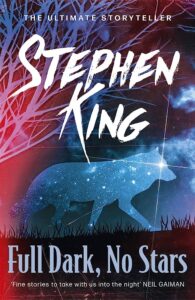Welcome back to Inconstant Reader, the inconstant feature column that explores Stephen King’s books in the order they were published — sort of! Warning: this piece is full spoilers, no stars.
Stephen King’s novellas have reached some legendary status over the years.
After all, the mostly non-horror anthology Different Seasons (1982) inspired films Stand By Me (1986), The Shawshank Redemption (1994) and Apt Pupil (1998) to date. Four Past Midnight (1990) gave us more adaptations, and the near-perfect story The Sun Dog. The 1999 work Hearts in Atlantis has a deep connection to his Dark Tower cycle.
So, with FULL DARK, NO STARS (2010) we see him returning to this type of storytelling after almost a decade. The four stories in the comparatively small volume, which means anything less than 400 pages for our friend Stephen, are not directly connected. Yet they are thematically linked by ordinary people acting out dark desires or on pure survival instincts.
The opening salvo is 1922, the lengthiest story of the bunch. Set in the titular year, in the familiar-sounding town of Hemingford Home, Nebraska, we meet Wilfred and Arlette James in the middle of a marital dispute. Arlette wants to sell her inherited farmland and move to Omaha, while Wilfred wants to remain and continue farming. As you might guess, Wilfred’s plan comes with fatal intent, ultimately involving their son Henry in a plot of murder and deceit.
1922 takes its sweet time getting to where it goes, very deliberately I might add, but that just adds to the tension. Set over the course of a year that goes to hell, it’s the first of several stories in the bunch that explore the idea of how far down the rabbit hole (or in this case, the well out back) you go once you start down the path of misdeeds. It doesn’t just infect the father but the son, with a subplot of Henry impregnating a farmer’s daughter and going on a Bonnie and Clyde spree across America.
On one level, 1922 is a ghost story. Once a deed is done, Wilfred is perpetually haunted: not just by Arlette and what he has done, but by the rats that seem to follow him everywhere. It is never clear whether this unnerving motif of rats in the walls, something that King has revisited on multiple occasions, is real or part of Wilfred’s delusions.The story ends by shifting from a first-person account to a newspaper article, forever leaving doubt in the minds of Constant Readers.

By contrast, Big Driver starts with something that seems like a King staple: a mystery writer on her way to give a talk at a library. On her way back, she takes a recommended shortcut, but is abducted, held prisoner, and raped by a trucker. The remainder of the story is both a tale of investigation and revenge.
One of the things that struck me about this story was that it follows a repeated use of rape as a plot device over the last few novels and short stories published around this time. In the collection Just After Sunset (2008), The Gingerbread Girl covers similar ground of abduction and escape. In Under the Dome (2009), several sexual assaults are revisited multiple times in sickening detail. When writing about the latter, I said “At one point I wanted to call back in time and check up on 2009 Stephen to see if he was okay.”
The story was later made into a film for Lifetime, which seems appropriate. Much of the story plays on the kinds of rape-revenge tropes you’d see in a Movie of the Week, right down to the ending – one that treads dangerously close to a victim having to justify her own outrage.
A Fair Extension is the shortest of the bunch. It takes place in Derry, a town that has never been quite right. Dave Streeter, who is dying of cancer, is offered a chance for a fair extension of his life by George Elvid (geddit?), a mysterious figure who claims to have lived for centuries. He can’t give Streeter immortality, but he can extend his life a bit. The monkey’s paw is that he has to give the misfortune to someone else. He chooses his ostensible best friend, who he has secretly hated for years.
Perhaps it’s that I’ve read this for the first time on the other side of Gwendy’s Button Box (2017 with Richard Chizmar) and its sequels, but this felt like familiar territory. Indeed, the kicker at the end – with Streeter seemingly contemplating trading his wife’s life for a little more time – feels most like a Twilight Zone episode.
If that theme of people pushed to dark places runs through the first three stories, then A Good Marriage puts it up on the marquee and runs with it. Darcy Anderson, married to accountant Bob for 27 years, finds two things in his garage by chance: a collection of pornography with sadomasochistic imagery, and the identification cards of a victim of the known serial killer “Beadie.”
Debating whether or not to confront him, he figures something is wrong and admits it to her. The only rub is that he has convinced himself that a childhood friend has ‘infected’ him, thereby justifying his actions in his own mind. Darcy ponders whether she can live with this knowledge, but ultimately plots to kill him. King was reportedly inspired by Dennis Rader, also known as the “BTK Killer.”
“The stories in this book are harsh. You may have found them hard to read in places,” writes King in an afterword. This is because FULL DARK, NO STARS is a collection that lives up to its name. Very little light permeates these stories, and they are frequently disturbing in their outlook. Indeed, coupled with the microcosm of Under the Dome that preceded it, King’s outlook on the first decade of the 20th century can be described as ‘bleak’ by this point. Yet the stories are also endlessly readable, filled with characters who are painfully true to themselves and honest, if not always likeable.
When Inconstant Reader returns, we travel back in time (and return to Derry) as we take a look as that infamous date, 11/22/63.





